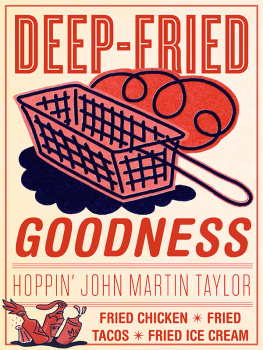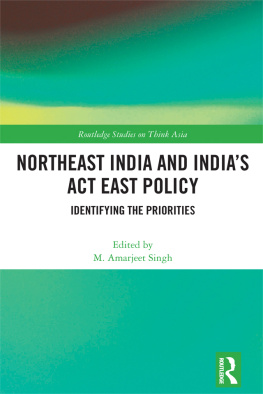DEEP-FRIED GOODNESS

BY HOPPIN JOHN MARTIN TAYLOR
ILLUSTRATIONS BY PETER ALSBERG
WORKMAN PUBLISHING NEW YORK
Copyright 1997 by John Martin Taylor
Book illustrations copyright 1997 by Peter Alsberg
All rights reserved. No portion of this book may be reproduced mechanically, electronically, or by any other means, including photocopying-without written permission of the publisher. Published simultaneously in Canada by Thomas Allen & Son Limited.
Deep-Fried Goodness is an abridgment of material previously published in The Fearless Frying Cookbook.
The words Hoppin Johns is a registered trademark of John Martin Taylor.
Cover design by Laura Foxgrover
Workman Publishing Company, Inc.
225 Varick Street
New York, NY 10014
www.workman.com
CONTENTS
INTRODUCTION
GETTING STARTED

References to frying appear in ancient manuscripts in both the East and the West, although no one can pinpoint the origin of the technique of cooking in hot oil. The evolution of frying as a cooking method probably closely follows the development of metal pots. Today we take so many of our modern conveniences for granted that we forget that the modern western kitchen, unimaginable a hundred years ago, is still unheard of in much of the world. Accurate thermometers, rheostats, and thermostats are recent luxuries. Sauting, for example, appeared only after stoves with variable heat sources appeared in the nineteenth century. Frying, then, as we know it, is very modern cooking.
DEEP-FRYING, THE PERFECT MEDIUM
Theres hardly a person among us who can resist perfectly fried onion rings, French fries, hushpuppies, or doughnuts. When cooked to perfection in clean, hot oil, deep-fried foods are crisp on the outside and moist and tender on the inside. They should not be greasy at allnot even a drop of oil on the plates that hold them.
When it is deep-fried, the food is surrounded by very hot fat (over 100 degrees hotter than boiling water), which sears the exterior by caramelizing the natural sugars in the food. The sizzling noise is the instantaneous vaporization of water as it hits the hot oil. Baking, broiling, and grilling can be done at hotter temperatures, but only in deep-frying is the heat so directly transferred to the food. The cooking is fast and, as long as the food is properly prepared, even.
Deep-frying is the perfect way to cook foods that dont have a dense or fibrous structure, such as many seafoods, vegetables, and batters. It is also an ideal medium for cooking croquettes and fritters made of foods that have previously been cooked. There are no great secrets to deep-fryingjust a handful of rules.
1. Read the recipe all the way through and assemble all the tools and ingredients before you begin.
2. Always use clean oil. You can use the vegetable oil of your choice, but I generally recommend peanut oil for deep-frying. It has a high smoking point and lasts longer (is more stable) than most. Most animal fats will burn, or reach the smoking point, when heated to 375F; some vegetable oils have a smoking point as high as 450F. Those that have been hydrogenated and those that contain preservatives and emulsifiers, such as commercial vegetable shortenings, have much lower smoking points. The smoking point is lowered every time a fat is used.
3. Choose a pot that is larger than the heat source. Oil catches fire easily, so you want to avoid any spilling. Cast iron conducts heat evenly and holds it well, but most cast-iron skillets arent deep enough for true deep-frying. A cast-iron Dutch oven, however, makes a good frying pot. The larger the surface area, the faster the decomposition of the oil, so manufacturers have designed electric deep-fryers that are tall and narrow. One disadvantage to this type is that they dont hold much food at one time. Also, many electric fryers do not have a thermostat; shop accordingly.
4. Never fill a pot more than half full of oil. Youll need at least 3 inches between the surface of the oil and the top of the pot to allow room for the oil to bubble up.
5. Constantly monitor the temperature. Youll need a high-quality candy or deep-frying thermometer (available in restaurant supply houses if your local grocer or kitchenware shop doesnt stock one) that accurately measures temperatures from 325 to 450F. Buy one that is designed with a metal sheath that prevents anything but liquids from touching the graduated glass tube; youll want one with a clamp on it as well, so that you can attach it to the side of the pot. Place the thermometer in the oil and turn the heat to the required temperature. Do not put the heat source to its highest setting; youll want more leeway when the frying begins. The instant the oil reaches that temperature, add the food. Carefully maintain the temperature throughout the frying. Most deep-frying is done around 365F (just remember the number of days in a year). If you find yourself without a thermometer, drop a cube of home-style white bread into the hot oil: at 350F the bread fries to a golden brown in about 1 minute; at 375F, it takes about 40 seconds. A few raw doughs can be fried crisp at temperatures slightly lower than 340F, but they are the exception. Follow the temperatures indicated in each recipe.
6. Do not crowd the pot. Add only as much food as the pot can hold without the pieces touching. The oil should bubble up freely around each piece, and the temperature should not drop.
7. Use proper tools for adding and removing foods. Some fryers come with frying baskets that allow you to lower and raise the foods all at once. Baskets have two disadvantages: adding all of the food to the oil at the same time can cause the temperature to suddenly drop below 340F, at which point the food will absorb the oil and become greasy; also, batters often stick to the baskets. I use long spring-loaded tongs, an Oriental wire mesh skimmer, or a slotted utensil made expressly for the purpose (mine, a Kitchamajig, was my mothers; its still being manufactured). Avoid slotted spoons; oil often gathers in them.
If you dip your utensil in the hot oil before picking up foods to be fried, batters and breadings wont stick.
8. Remove the foods in the exact order in which they were added to the pot so that they are all evenly cooked.
9. Drain the fried foods well of all grease. The advantage of fryer baskets is that they usually have a hook that suspends the pot over the oil, where any excess grease can drain off. If youre not using a basket, simply hold each piece of food over the pot for a moment, turning it so that all grease drips back into the pot; then place the fried food on a wire rack that is placed over a baking sheet, where it will drain further. Do not place the food on paper towels or on brown paper unless the recipe tells you to do so.
10. Keep the food warm while you prepare the next batch. Few fried foods can be prepared in one batch. Have an oven preheated to its lowest setting and simply place the foodsitting on a wire rack that is set on a baking sheetin the oven while you continue frying.
11. Always follow all of these rules with each batch.
Next page















